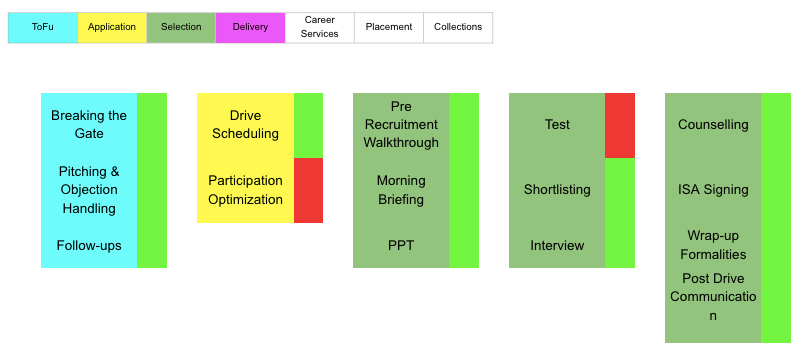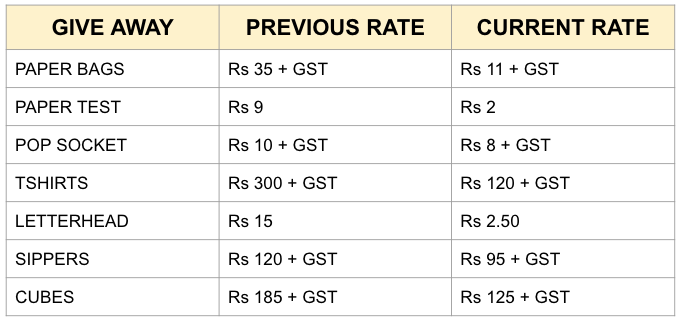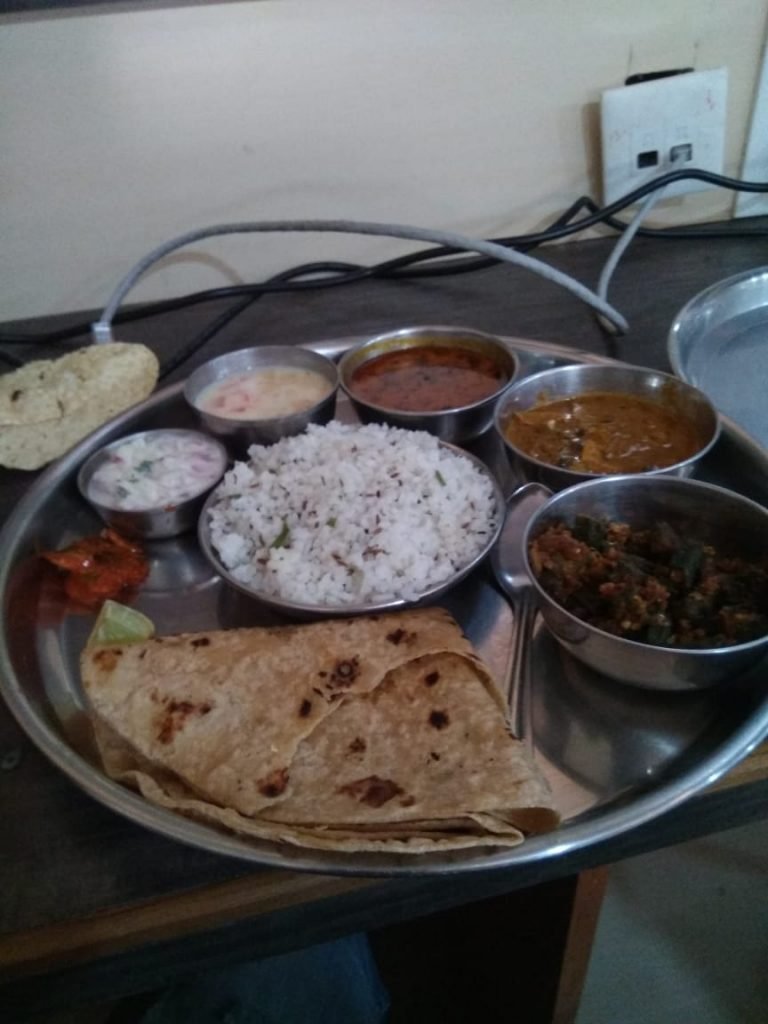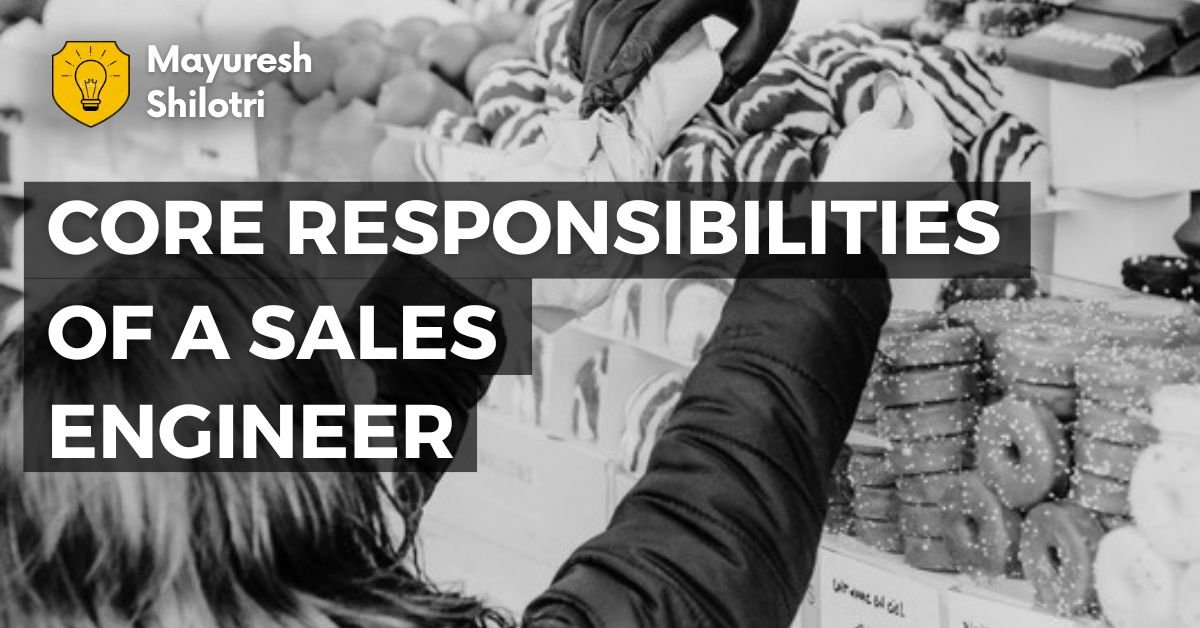I write this from having travelled 16,000 kms across the State of Maharashtra, India in 3 months. Visited 170 Colleges. Conducted 26 Drives. Tested 4600 students and recruited/ signed ~350 learners into the Income Share Agreement based program.
All views are personal. Need not represent those of my organization or investors. I have anonymized the identity of certain colleges and people wherever I have got critical feedback to share of people/ events/ circumstances. Based on as much data as possible.
- Words:4489 (Skim friendly)
- Type: Post
- Video:0
- Slides: 0
- Topic: Humans Of EdTech
- TIME: 6 Minute
Today we’ll be looking at the income share agreements as a business model in India, and what experiences we have had at GreyAtom regarding the income share agreement as a model. Just to give you some sense of timelines, in August 2019, we launched our Frontend Engineering Program in the income share agreement model. We built out the content curriculum, online application form, so on and so forth. And we went live by September, and we started up accepting applications, vetting them, reviewing them. So September, October, we essentially spent in that. In November 2019, we started with the campus outreach, that’s where the bulk of recruitment happened in the income share agreement model. So in this structure, that we will have a look at how the campus outreach was done, and what successes & life experiences we had over here.
We just want to give you an overview of what the market looks like at a very high level, what is it we exactly did over here, what iterations we put in, what improvements/innovations we have bought into the whole process, finally, some learnings from the models, what inputs we have for the other teams, other business teams within GreyAtom,what can work possibly in the campus model on that part. And finally, some road ahead. On March 2, 2020 this deck, this was built in 2020. This is just before the pandemic officially hit India.

If you look at the universe of the engineering colleges in India – we’re looking at a very large number. We’re looking at seats, which are, you know, 17 or lakhs. So that’s the number of active students in the engineering system, including the undergraduates and postgraduates. If you look observe carefully, the top five states of Tamil Nadu, Maharashtra, Uttar Pradesh, Andhra Pradesh, and Telangana, accounted for over 50% of the total number of states number of colleges in the whole country. If you zoom into the Maharashtra Geography, that’s where we are, we are based out of Mumbai. So if you just break it down at the district level, so out of the 36 districts, or geographical units are areas we’ve identified all the green ones that we have marked as the places where we have gone and visited and have had some sort of face time.
And the other places that is Pune, Mumbai and Thane, so we can hit them at any point in time. So we essentially went to geographies other than these three, we hit all of them. So we’ve conducted close to 26 drives to the best of my knowledge, so this is slightly dated table. And we have recruited 272 students. The total test takers were 3194. Total number of interviews that we did was 793. So these are some top level numbers just to give you a sense of what we exactly did.

This is essentially the pipeline view of maturity. So what I’ve done over here is from the left-hand side, and the less top of the funnel, application, stage selection, delivery, Career Services placements, and collections. So this is the value chain of the whole income share agreement model. And if you look at this thing, what you’ve done is you’ve just put some sort of colour code – green or red. So, the green says that we have achieved a fair amount of maturity over here. And the red one says it will not achieve any kind of maturity. So under my purview, specifically, where the top of the funnel application and selection, delivery onwards, a separate team is to look into that part.
So in the top of the funnel, you will see breaking the gate, pitching, an objection handling and follow-ups. So regarding breaking the gate, getting the drive lined up, getting them to sign the agreement, helping them understand what the whole thing is, all the objection handling, all the follow-ups, that is all completely done. So we have a good handle on that thing.
Regarding applications, scheduling the drive, optimizing the participation, we have had a good handle on this thing. The optimizing the participant is something that we could have done much better. With respect to the selection is the pre-recruitment walkthrough, the morning briefing, the presentations, the tests, short-listing interviewing, counselling, ISA signing, wrap-up formalities and post drive communication. We have achieved a substantial amount of maturity across the process. The test is still something that we need to constantly work on. We have a very clear direction of what we want to try over here. But we need to take that step.

So just to give you a timeline view of you know how we went about maturing this thing, right from November 1, 2019, when we sent out a proposal for sponsorship to the December, where we actually conduct a lot of business development activity. We conducted all these Campus Recruitment Drives in January 2020. And right up till the entire month of March 2020. Great.
So what iterations did we do? What innovations do we bring to the complete process, so let’s quickly have a look at the whole thing? So you made the giveaway is much more likely the giveaway winner since anything that you put the student once they get placed. So we made it much lighter, much cheaper, super inexpensive, and very easy to do. Then the async ISA signing, the ISA signing will itself process so to speak, people used to take time to sign it and there used to be a big drop at that stage. So how do you get people to sign the ISA is essentially a process to capture the documents, Aadhar card, PAN card or other financial documents, so we captured them using JotForm.
Remove the presentation at the end of the day, so we used to do two presentations one in the morning, one in the evening. So we remove the presentation at the end of the day.
We used to select five people who have failed the test and usually just put them randomly in the interview panel to see that whether the interview panel has the discriminative power.
- Make Giveaways lighter
- Async. ISA signing
- Jot Form
- Remove PPT at the end of the Day
- 5 Random Entries
- Morning Briefing to Volunteers
- Pre-Drive Prep – Packing
- ‘Zero Luggage Drive’ Person
- Kit Maturity
- Pre-Placement Talk versions
And the kit definitely has come of age – what we typically give away to the Principal, HoD, TPO & Students. So this has become very, very light.
And the pre placement talk has undergone multiple iterations. So right from a very thick pre placement of a very thin pre placement, delivered in neutral language, local language also made it more entertaining. I think all those details are further captured.

So just to give you a timeline view of you know how we went about maturing this thing, right from November 1, 2019, when we sent out a proposal for sponsorship to the December, where we actually conduct a lot of business development activity. We conducted all these Campus Recruitment Drives in January 2020. And right up till the entire month of March 2020. Great.
So what iterations did we do? What innovations do we bring to the complete process, so let’s quickly have a look at the whole thing? So you made the giveaway is much more likely the giveaway winner since anything that you put the student once they get placed. So we made it much lighter, much cheaper, super inexpensive, and very easy to do. Then the async ISA signing, the ISA signing will itself process so to speak, people used to take time to sign it and there used to be a big drop at that stage. So how do you get people to sign the ISA is essentially a process to capture the documents, Aadhar card, PAN card or other financial documents, so we captured them using JotForm.
Remove the presentation at the end of the day, so we used to do two presentations one in the morning, one in the evening. So we remove the presentation at the end of the day.
We used to select five people who have failed the test and usually just put them randomly in the interview panel to see that whether the interview panel has the discriminative power.
- Make Giveaways lighter
- Async. ISA signing
- Jot Form
- Remove PPT at the end of the Day
- 5 Random Entries
- Morning Briefing to Volunteers
- Pre-Drive Prep – Packing
- ‘Zero Luggage Drive’ Person
- Kit Maturity
- Pre-Placement Talk versions
And the kit definitely has come of age – what we typically give away to the Principal, HoD, TPO & Students. So this has become very, very light.
And the pre placement talk has undergone multiple iterations. So right from a very thick pre placement of a very thin pre placement, delivered in neutral language, local language also made it more entertaining. I think all those details are further captured.

Process Standardization (while being on the road)
|
# |
Name |
|
1 |
First Visit Summary |
|
2 |
Travel Plan |
|
3 |
Pre Recruitment Checklist |
|
4 |
On the Day Checklist |
|
5 |
Thank You Letter/ Email |
|
6 |
Feedback Form |
|
7 |
Preparation Mail |
|
8 |
Rejection Mail |
|
9 |
Proposal |
|
10 |
Letter of Intent |
|
11 |
ISA |
|
12 |
Counselling Deck |
|
13 |
JotForm for Document Collection |
|
14 |
Interview Selection / Rejection Form (Rubric) |
So standardisation of the process, I’m going to take you through these documents, but later, but I think these documents are the first summary visit. The first summary visit is when someone’s going to Team GreyAtom goes and visits the college, they need to capture a certain number of details. So that’s all over here. The travel plan needs to be submitted, the pre-recruitment checklist what they need to have before the recruitment, on the day checklist, thank-you letter, email feedback form, the preparation mail, rejection mail, proposal, a letter of intent, is a counselling bag. And some of these documents have been meticulously iterated like the letter of intent, the letter of intent has to be as per the NBA norms. It has to be NBA approved. So we got it reviewed by a person who is typically on the review panel. For the NBA, who does these audits across campuses, that person gives us the Go ahead. Finally, the document collection form and the interview selection rejection form. So I think the interviewers were remote, they were not on campuses. So how do you essentially have a very seamless communication process between two of them? That’s the thing that we achieved over here.
Testing – the testing is the evolution of the students that we do. Now, we started with an online system called as Coderbyte. We also did a paper-based test. To prevent plagiarism. We did the pink and white question paper sets for randomization. We would distribute the paper as a Grid.
Selection process – We had aptitude, aptitude plus coding assignment, aptitude plus coding output, aptitude plus coding output and coding completion. So a lot of different tests were essentially tried out. We went with a paper-based test, because I think the electricity connections in some of these rural areas, and the internet connections, were not robust enough, people have the hardware, but some of this software or the firmware items are still not up to the mark. So we had to go with a paper based test. And the paper base just has to be something very easy that invigilator can check, so on and so forth. And we need to take care of the moral hazards that come with evaluation invigilation, all those kinds of things. So the painted white is essentially you had these papers printed on one sheet of paper, printed on the pink paper and one on the white paper needs to give it an alternate basis to students so that the chance of copying essentially goes down.
But that’s something that’s being done. interview. So I think what we typically found is that a lot of people are from modest economic backgrounds, and that is typically the understanding of a city slicker. People who have been born and bred in cities they have that kind of understanding as well the reality can be slightly different. We really need to understand what kind of land parcel do they own, what farm animals that they have, it can turn out and people who have who are farmers in a particular greenbelt, water rich belt, they are very affluent. So farmer may not be poor.
Have you conducted in person interview or the conduct online interview with a lot of training on this part? coding assessments? How do you administer them flowchart for rejection? So I think standardisation of processes, basically anything as much as you can centralise and we also identified leads from the for the interviewers. Because we’ve all found these selection issues to be different across interviewers. So, how do you train them and make the entire process very, very standard? Right, so when you put together the ISA agreement, which was very much inspired by the ISA agreements, drafted by some other ISA players in the Indian market, and also adopted by the American players like Lamda School.
So these ISA clauses are relatively very stringent. And if you put some of these ISA clauses that I think we essentially are losing the channel access. So we had to relax certain clauses.
Clauses we relaxed were
- Penalty
- Longer Look-in
- No Lock-in

Offline
- Clear identification needs to be done in students coordinators
- We need to accept copying, it cannot be completely controlled
Online
- More prone than offline
- Browser enabled
- No partition between computers
- Student coordinators from 3rd year CS help
- 1 person 8 distant labs cannot be monitored by GA
- Finger coordination
It is not to cast any aspersions regarding the moral compass of the teaching staff. But more or less, this has been the experience that in the offline setting, the copying is very, very rampant. And you essentially need to have process based measures to control it. So things that we spoke about the pink and white papers randomization over there, those are the things that you will need to have, because what happens is, let’s say 600 people are taking the test. Now one person per bench and you have like a 40 to 60 seater. So for 40 to 60 seater classroom, you’re going to need 10 classrooms. Now, all these 10 will not be in a single building. This will be spread out across three or four buildings. So there is absolutely no possibility that we can individually all these four buildings and 10 classrooms concurrently, it will be high fidelity. So you will need to leverage the local staff and local volunteers, the staff is not something or someone who really volunteers for these things. So this is a fact of life.
For the online thing, it is well more prone than the offline thing. Whatsoever you invest in remote proctoring. or anything of that sort is just not possible. You know, even if you say that it is AI based eyeball tracking, mechanism, tabbing control, all those kinds of things. But you can control the timing, but you cannot control people talking to each other or sitting next to each other. And that’s the difficult bit. So there is no partition between the computers. There are multiple browsers, it’s very difficult to control. So basically, third year, people are invigilating the fourth year people. So it’s very difficult. And then there are things you know, where people figure out brilliant ways of communicating where in case you have multiple-choice questions, and you need to answer the ABCD. So it is very easy to answer them with fingers. You don’t need to say anything, but you can just gesture 1234, which corresponds to ABCD. So people copy here rampantly.
There are risks to human imagination. Now, this is something that we came across as one of our team members. He was in one hall, where he took away papers off to people and asked them to leave the exam hall because they were copying. Now, we are touring in remote areas. And some of these are tier two townships. Now, we exactly don’t know whose paper we have taken, what kind of socio-economic background the student comes from. So there is definitely risk to human life, risk to property regarding, you know, taking people head-on and rubbing them the wrong way. Even though you know you’re doing the right thing, but you are an alien territory. And you’re essentially taking some disciplinary action, which is right, but can have its repercussions.
We actually came across something like this, where a person from our team essentially asked people to sit separately because of the risk of coffee. So at least four people ganged up on him, and they confronted him. Reason – They felt insulted. We offered them chocolates to call a truce. These students are very high on hormones, early 20s or even teenage students. So, there is risk to human life, to be very honest. Regarding human invigilation, so that’s a fact of life. And that’s just something that we have seen repeatedly, because it’s not that these are very uncivilised people or anything of that sort, but it’s just that we cannot be taking responsibility and liability for such behaviour, especially of your team members.
Photo by Kaboompics.com from Pexels.
Join to get sneak peek into what's happening
I write about books, experiences, product, UX, EdTech, early stage growth, validation – mostly tech. Subscribe if these topics interest you. Once every 15 days emailer. I promise – No spam. (I am known for it otherwise) 😉




